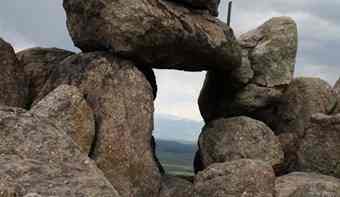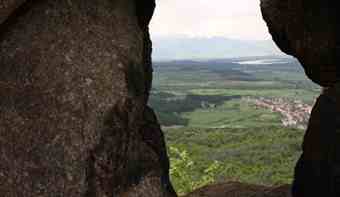Between the northern slopes of Surnena Sredna Gora and the Toundja River valley, lies the village of Bouzovgrad. It is five km south of Kazanluk and attracts tourists with one of the most ancient Thracian shrines – the Megalith (The Goddess’ Gate), a cult complex built from massive, oddly arranged stone pieces. The name alone calls to mind images of ancient sacrifices and rituals, so, in an adventurous mood, we hit the road to Kazanluk and the Valley of the Thracian Kings.
 After a lot of asking around, since there are no signs in the town, we find Bouzovgrad. The village is quite big, with high-rise houses and neat gardens, full of velvety peonies, lilac and wilted tulips. We get to the centre of the village without managing to find any directions to the Megalith. The old men sitting in the nearby pub immediately point out the way: "Just follow the road, there are even pictures."
After a lot of asking around, since there are no signs in the town, we find Bouzovgrad. The village is quite big, with high-rise houses and neat gardens, full of velvety peonies, lilac and wilted tulips. We get to the centre of the village without managing to find any directions to the Megalith. The old men sitting in the nearby pub immediately point out the way: "Just follow the road, there are even pictures."
Very soon boards start appearing, with detailed descriptions of tourist routes and sights in the region, plus a big photo of the megalith (in stark colours). The sign that concerns us is at the end of the village, by the bridge – Eco path to the "Goddess’ Gate" Megalith. We leave the car and start on a narrow path winding up to the top of the hill. The landscape alternates between thick beech woods and empty spaces, which allows us a view to the hill-top and the gathering storm clouds. The rain starts, just enough to cool our sweating bodies and to freshen up the air. The path has several detours but is well marked. We also see signs showing the direction to other, unknown places – Bouzovo Kale and Bashtin Kamuk.
Our question about how far the Megalith is and whether it’s near the Bashtin Kamak gets evasive answers from the first people we meet. Their embarrassment seems to grow when we ask the next question: "What does Bashtin Kamak look like?" There follows a string of explanations like "Hmm, well, they’re big stones with a very characteristic male shape", embarrassed laughter and eventually detailed directions on how to get there.
 A bit further upwards and we can see through the woods the silhouette of the Megalith. After a while, panting, we get to the meadow in front of that ancient shrine. Huge rocks form a massive structure with something like a window in the middle. According to the information on a big bilingual board, the Megalith was used for watching the sunset on the summer equinox (June 21), it was built around 1800-1600 BC by the ancient Thracians who used it also for astronomical research and calendar purposes. Now, in the middle of the day, the only thing visible through the "window" is part of the village and the Koprinka dam in the background.
A bit further upwards and we can see through the woods the silhouette of the Megalith. After a while, panting, we get to the meadow in front of that ancient shrine. Huge rocks form a massive structure with something like a window in the middle. According to the information on a big bilingual board, the Megalith was used for watching the sunset on the summer equinox (June 21), it was built around 1800-1600 BC by the ancient Thracians who used it also for astronomical research and calendar purposes. Now, in the middle of the day, the only thing visible through the "window" is part of the village and the Koprinka dam in the background.
We leave in a hurry to find the "characteristic" Bashtin Kamuk and the ancient fortress Bouzovo Kale. By the Megalith, there’s a meadow which is currently hosting a group of picnic-lovers and they are kind enough to give us directions, but that turns out to be not enough. Following the directions we get to another meadow, where the road forks into three. We choose to follow the sign for Bouzovgrad Fortress, but very soon reach a pile of rocks that in effect put an end to the road. We go back to the first meadow for more directions, and then see our "saviour" – a yellow pedestrian sign on which someone has written in a permanent marker the way to the fortress. The information is very detailed, and besides directions, includes, in Bulgarian and English, the names and the time it takes to get to the fortress and to the village. This time we’re lucky – we find the remnants of ancient fortress walls, ruins from mortared stones.
We couldn’t find the Bashtin Kamuk, however. It takes us hours of wandering around without success, and losing the path, but we’re left with the emotion and the fun we have every time we come across piles of rocks – isn’t this one the Bashtin Kamuk?
Places to spend the night: Nearby villages, and Kazanluk itself offer many guest houses. On its website, the Association for Sustainable Tourism, Kazanlak, www.kazanlaktour.com, offers detailed information about them as well as the option to choose based on a set of criteria.
Apart from traditional archaeological sights and museums in the Valley of the Thracian Kings, we recommend a walk around the beautiful Koprinka dam, in whose depths are hidden the remains of the ancient Thracian city of Sevtopolis.
Source: The Sofia Echo [August 06, 2010]
VIA «The Goddess’ Gate»